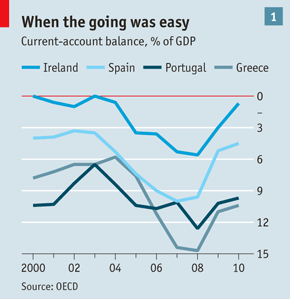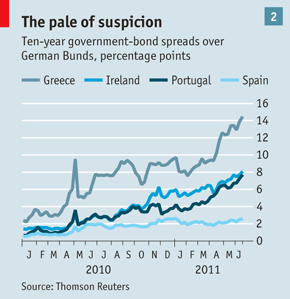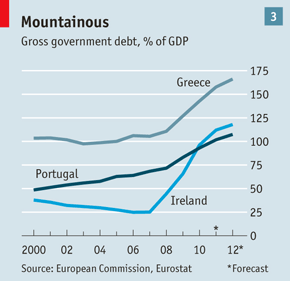|
The
euro crisis:
A
second wave
The bail–out
strategy that rescued Europe’s peripheral economies is
proving insufficient.
This threatens the whole project of
European integration.
The
Economist, Jun 16th 2011
Athens
and London.–
Europe’s year–long attempt to grapple with the sovereign–debt
crisis is becoming more nailbiting by the day. For weeks
European leaders have been feuding over what to do about
Greece, which clearly needs more help with its precarious
public finances. But a second rescue, adding even more
funding to the original bail–out in May 2010, cannot work
unless the Greeks push through more painful reforms. These
are now in doubt, sending tremors through financial markets
and causing stockmarkets to fall around the world.
From
the nation that coined the word drama, there was plenty of
it on June 15th. As a general strike took hold across the
country, there were violent protests in central Athens,
where tens of thousands of people had rallied. After failing
to form a government of national unity, George Papandreou,
the prime minister, announced that he would reshuffle his
cabinet and later call a vote of confidence in parliament.
The indignation of the protesters is widely shared. A recent
poll published by Kathimerini, a newspaper, found that 87%
of the public thought the country was heading in the wrong
direction.
The
same could be said for Europe’s approach to the sovereign–debt
crisis, as it has spread relentlessly round the southern and
western periphery of the euro area. The single–currency
zone as a whole is doing well, outgrowing both America and
Britain in the first three months of this year. The euro–wide
budget deficit also compares favourably with that of other
big advanced countries. But the debt crisis is proving
intractable, partly because leading policymakers disagree
about the way forward and at times seem lost themselves.
Time is short. There is a summit of European leaders next
week, and Greece must soon pass an austerity budget.
The way
it all began
With
hindsight, it was no surprise that the debt crisis started
in Greece, which failed to join the euro area when it was
set up in 1999 because it did not meet the economic or
fiscal criteria for membership. Revisions to its budgetary
figures showed that it shouldn’t have been allowed in when
it did join, in 2001. When its debt crisis flared up last
year European leaders hoped to contain it at the Greek
border, providing a bail–out worth €110 billion ($158
billion) over three years, of which €80 billion came from
other euro–area members and €30 billion from the IMF.
Any
hope of containment was shattered when Ireland’s banking
difficulties forced a second rescue last November. After
that a third bail–out became inevitable, for Portugal, as
the cost of its government borrowing shot up and Portuguese
banks were shut off from normal funding, coming to rely on
the European Central Bank (ECB), based in Frankfurt. What
caused consternation was a new shock—from Greece, again—that
the first package was insufficient and that the country
needed more money for longer.
This
sent European policymakers into a frenzy. Their attempts to
find a solution have sometimes seemed to spring from the
pages of an overwrought thriller. A secret session in early
May of some of the main negotiators in Luxembourg leaked out
amid official denials that it was even happening. Shortly
afterwards the IMF, which has been playing a crucial role,
lost its managing director when Dominique Strauss–Kahn had
to resign after charges were brought against him for
attempted rape in New York. Blazing rows have erupted
between Jean–Claude Trichet, the usually unflappable
French president of the ECB, and Wolfgang Schäuble, Germany’s
redoubtable finance minister, over German demands to inflict
some of the pain on private holders of Greek bonds and the
central bank’s resistance to anything that could be
construed as a default.
Europe’s
heads of state will decide on the second Greek rescue
package when they meet in Brussels on June 23rd and 24th.
Help will be forthcoming only if the Greek parliament
endorses the extra doses of austerity the country must
swallow, together with a big programme to privatise state
assets worth €50 billion (20% of GDP). Assuming that
Greece does buckle down despite the commotion of this week,
as it has promised, it can expect to get an additional €85
billion in bail–out funding that will now stretch to 2014.
How
much of this will have to come from taxpayers? The answer
hinges on how far private creditors who have lent to the
Greek government can be made to “participate”, a
euphemism for picking up some of the bill. The Germans have
been pressing hard for debt maturities to be extended; the
ECB has been adamantly opposed to such a policy, although it
may accept a promise by bondholders to buy new bonds when
the existing ones mature. Worries about a possible
restructuring led Standard & Poor’s to downgrade Greek
government debt this week from B to CCC, making it the
credit–rating agency’s lowest–rated sovereign debt in
the world.
Already
the prolonged irresolution of European leaders about a
second Greek bail–out has increased uncertainty for
investors and businesses. If they make a false move, the
repercussions will affect not just Europeans but Americans
too, and indeed the global economy. President Barack Obama
recently said that America’s growth depends on a
successful resolution of the Greek crisis; an uncontrolled
default (the first in an advanced country since 1948) would
be disastrous. The risk of contagion to other countries
through banking losses, which prompted the original rescue,
remains acute, not least since the markets would immediately
fret about Ireland and Portugal falling in turn. Worries
would be rekindled, too, about Spain, which has so far
managed to avoid needing a bail–out.
But
a still bigger issue is at stake. Even if the European
Council manages to cobble together a compromise that buys
time for Greece, the fear is that Europe’s bold experiment—creating
a monetary union among diverse economies without the
underpinning of a fiscal union—may have been too audacious.
If it founders, this would be an extraordinary setback for
the larger cause of European integration.
Charlemagne’s
coin
Europe’s
creation of a single currency remains both futuristic and
weighted with history. At a conference about the ECB on June
10th, Volker Wieland, an economist at Goethe University in
Frankfurt, said that the euro was the first venture on such
a scale in Europe since Charlemagne created a single
currency in his empire in 794. In more recent history
central banks have capped political unions—as when the
Reichsbank was founded in 1876 in the aftermath of Bismarck’s
unification of Germany through “blood and iron”.
The
ECB, by contrast, is a supranational institution, although
it emerged from an old–fashioned Franco–German deal. The
French wanted to fetter German power—in particular the
dominance of the German central bank in European monetary
policy—after its second unification, in 1990, following
the fall of the Berlin Wall. The Germans believed the ECB
could be their Bundesbank writ large. Along with these
political objectives, the single currency was expected to
produce economic gains by eliminating the nuisance and cost
of having to change money within Europe, removing exchange–rate
uncertainty within the euro area and enhancing price
stability. The mantra of its proponents was “one market,
one money”. The single currency would reinforce the single
market, emerging from reforms in the late 1980s and the
early 1990s to open national economies to Europe–wide
competition.
A
stand–alone monetary union without the usual fiscal and
political foundations was conceived at the momentous
Maastricht summit in December 1991. The treaty set
“convergence” criteria, such as low enough inflation and
long–term interest rates, to check whether countries were
economically fit enough to join the single currency. These
also included fiscal criteria, notably ceilings for budget
deficits of 3% of GDP and for public debt of 60%. The treaty
stipulated that there would be no bail–out of a country
that got into fiscal trouble.
But
the rules were less strict than they appeared. Belgium and
Italy were allowed to join the euro at the outset, even
though their debt exceeded not 60% but 100% of GDP—because
that debt was falling. Economic convergence at one point in
time also proved misleading. What determines whether a
country can survive, let alone thrive, in a monetary union
is flexibility in both labour and product markets, since it
can no longer realign its costs by devaluing.
As
for the fiscal tests, what was to stop countries from
misbehaving once they had joined? The answer, tacked on in
the late 1990s to the Maastricht criteria, was a
“stability and growth pact” to reinforce responsible
public finances within the euro area. But this too was
watered down in 2005, largely at the insistence of France
and Germany, after they themselves faced possible sanctions
for breaching the budget–deficit limit.
None
of this seemed to matter during the first few years of the
monetary union. While Germany went through a weak patch, the
peripheral economies (Portugal excepted) flourished, thanks
to the low interest rates that euro membership brought them.
The elimination of exchange–rate risk unleashed cross–border
lending, which built up large exposures among the banks in
the lending countries while debt piled up in the borrowing
countries.
The
lending was on lax terms. Credit markets paid no heed to the
risks that were building up from sustained big current–account
deficits, which would have caused alarm in emerging
economies (see chart 1). They smiled on Ireland’s property
boom, overlooked Portugal’s slack growth and forgave
Greece its poor public finances. Spain also benefited from
dirt–cheap money even though it shared many of the same
weaknesses, notably a housing–market bubble and a huge
current–account deficit.
Weakness
exposed

The
flood of easy money disguised the hard truth that the
competitiveness of the peripheral economies, gauged by
measures like unit labour costs, had steadily worsened after
joining the euro. This deterioration came from a poor
starting–point, for Greece in particular. As one senior
negotiator in the bail–out talks laments, Greece is part
of the single–currency area even though it has managed in
effect to stay out of the single market. With the lowest
exports–to–GDP ratio in the euro area, membership became
a way to import cheap goods on the never–never rather than
a means to foster higher productivity. Ireland, with exports
now roughly equal to GDP, is quite different, but Portugal
also has a lowish exports–to–GDP ratio for a small
economy within a single–currency zone and, like Greece,
has insulated much of its economy from the single market.

Once
the credit machine went into reverse as the financial crisis
broke in the summer of 2007, the underlying weaknesses of
the peripheral economies were exposed. The debt that had
piled up in the good years became oppressive once lenders
scented trouble. Spreads on government bonds over safe
German Bunds, which had earlier narrowed to wafer–thin
margins, ballooned out (see chart 2). Ireland had what
looked like impeccable public finances, with government debt
as low as 25% of GDP in 2007, but these were flattered by
swollen property–market taxes and then swamped by the
costs of propping up banks that had gone on a bender, the
bill for which is now reckoned at 42% of national output. As
a result, the debt burden will reach 112% this year,
according to the European Commission’s May forecast.
Portugal’s, too, will vault above 100% of GDP, while
Greece’s will rise to almost 160% (see chart 3).

Fundamentally,
then, the crisis that has engulfed three countries is rooted
in a severe loss of competitiveness combined with levels of
public debt that look unsustainable in the case of Greece
and worryingly close to that for Ireland and Portugal. The
rescue packages are accordingly trying to shake up the
sclerotic economies of Greece and Portugal through sweeping
changes to liberalise markets controlled by producer
interests. The priority for Ireland’s more flexible
economy, which has been regaining some of its lost
competitive ground, is to finish healing its banks. All
three economies are having to push through harsh austerity
measures to create primary budget surpluses (ie, before
interest payments) that will stabilise debt. As long as the
three live up to their side of the bargain, the European
creditor nations, led by Germany, have been prepared to
provide bridging finance.
Voter
resistance
The
bail–out strategy made some sense in May 2010, since
banking systems were still weak after the convulsions of
2008, exposures to Greek debt were not well mapped out and
private creditors had had little time to adjust their
positions. But it has lost credibility over the past year as
Ireland and Portugal have also succumbed, and as markets
have concluded that a bail–out will fail to put Greek debt,
in particular, on a sustainable path.
Inherently,
there are two conflicting economic tensions in the rescue
packages. The first is that the austerity programmes needed
to cut deficits are killing the growth needed to make debt
bearable. If Greece had got into trouble outside the euro,
the drachma would have fallen, creating an external
offsetting boost to the economy by making exports cheaper
and curbing imports. The other inherent tension is that the
steps needed to improve competitiveness within the euro
require prices and wages to be held down, making it even
harder to cope with debt.
There
are also conflicting political forces within both the
borrowing and lending countries. The Greeks are not alone in
feeling resentful about having to pay so high a price for
past misdemeanours. Many Irish now see themselves as victims,
paying a penalty for having done a favour to other European
countries by propping up their banks and thus preventing
losses by foreign bondholders that had lent to them. If the
mood turns sourer, it may be harder for the new Irish
government led by Enda Kenny to push through the further
austerity that is needed.
Lender
countries are also becoming restive. The recent general
election in Finland propelled a loan–refusenik party, the
True Finns, to third place in the polls. In Germany a
majority of the public thinks that the original rescue of
Greece was a mistake. On June 10th the ZDF Politbarometer
showed 60% rejecting further assistance and only 33% backing
it. A poll in April showed an overwhelming majority fearful
that more countries than Greece, Ireland and Portugal will
require help.
This
stroppiness means that one solution to the debt crisis is a
non–starter. Sharing budgetary resources, either through
direct transfers or through the issue of “E–bonds”
underwritten by the euro area’s taxpayers, is anathema in
Germany, where the notion of a “transfer union” in which
the better–off subsidise the worse–off is political
poison, not least because of the vast transfers from western
to eastern Germany since reunification. Northern taxpayers
would also recoil from the idea of a future “ministry of
finance of the union” which Mr Trichet recently floated.
An
alternative course would be to try to make a “no bail–out”
model work. Jordi Galí, an economist at Pompeu Fabra
University in Barcelona, would ban collective rescues and
stop trying to patrol euro–area states through debt and
deficit limits. Instead he would leave the job of policing
their public finances to investors. This would require
recapitalisation of European banks so that they could
withstand sovereign defaults, but that is not the only snag.
The pass has already been sold. Investors know that when a
banking crisis looms, European governments will flinch and
extend taxpayer support.
Both
these courses of action at least offer clear paths forward.
By contrast, the long–term reforms set out by European
leaders in March fall short of the comprehensive solution
they purported to provide. Under a “pact for the euro”
there will be economic and fiscal workouts that will allow
countries to cope better with the rigours of monetary union—including,
for example, greater wage flexibility. They will have to put
into law their determination to get a grip on public
finances. The temporary support measures will be turned into
a permanent “stability mechanism” with an effective
lending capacity of €500 billion that will be available to
countries only if their debt is deemed sustainable. Private
bondholders are served notice that they will be at risk from
mid–2013 when the new regime comes into force.
In
effect the reforms formalise the bail–out strategy, but
try to ensure it will not have to be used again and leave
open the possibility of restructuring. One objection is that
the pressure remains on deficit countries within the euro
area to put their houses in order, whereas none is brought
to bear on surplus countries such as Germany. But the bigger
worry is that the reforms will be overtaken by events.
The
European summit on June 24th seems unlikely to get on top of
things. Even if private bondholders can be made to share in
some of the pain by rolling over their debts, this will
still leave Greek public indebtedness unsustainably high. As
long as that is so, markets will continue to bet on an
eventual default. The pre–summit wrangling has only served
to underline the extreme difficulty of reaching any solution
that can be sold successfully to voters. The Greek protests
have forcibly made the point that debt sustainability is
ultimately a matter of political resolve.
At
best, European leaders may buy more time. But the markets
have a different timetable from the politicians, and their
scepticism may continue to undermine the weaker economies by
hurting their banks. Though the ministers will doubtless go
on talking, it is increasingly hard to see a safe way out of
this crisis.
|